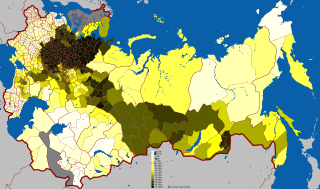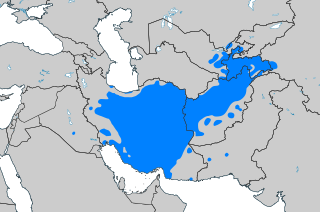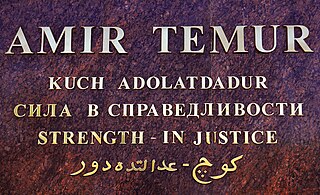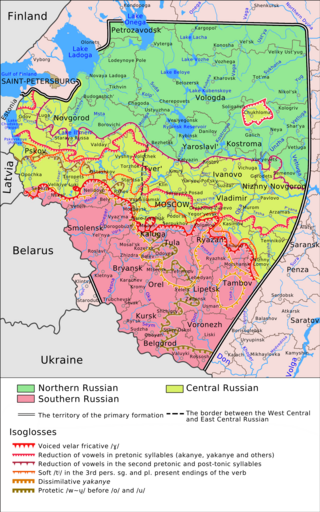
Russian is an East Slavic language, spoken primarily in Russia. It is the native language of the Russians and belongs to the Indo-European language family. It is one of four living East Slavic languages, and is also a part of the larger Balto-Slavic languages. It was the de facto and de jure official language of the former Soviet Union. Russian has remained an official language in independent Russia, Belarus, Kazakhstan, Kyrgyzstan, and Tajikistan, and is still commonly used as a lingua franca in Ukraine, Moldova, the Caucasus, Central Asia, and to a lesser extent in the Baltic states and Israel.

Tajikistan, officially the Republic of Tajikistan, is a landlocked country in Central Asia. Dushanbe is the capital and most populous city. Tajikistan is bordered by Afghanistan to the south, Uzbekistan to the west, Kyrgyzstan to the north, and China to the east. It is separated from Pakistan by Afghanistan's Wakhan Corridor.

The Demographics of Tajikistan is about the demography of the population of Tajikistan, including population growth, population density, ethnicity, education level, health, economic status, religious affiliations, and other aspects of the population.

Tajiks are a Persian-speaking Iranian ethnic group native to Central Asia, living primarily in Afghanistan, Tajikistan, and Uzbekistan. Tajiks are the largest ethnicity in Tajikistan, and the second-largest in Afghanistan and Uzbekistan. They speak varieties of Persian, a Western Iranian language. In Tajikistan, since the 1939 Soviet census, its small Pamiri and Yaghnobi ethnic groups are included as Tajiks. In China, the term is used to refer to its Pamiri ethnic groups, the Tajiks of Xinjiang, who speak the Eastern Iranian Pamiri languages. In Afghanistan, the Pamiris are counted as a separate ethnic group.

Tajik, also called Tajiki Persian or Tajiki, is the variety of Persian spoken in Tajikistan and Uzbekistan by Tajiks. It is closely related to neighbouring Dari of Afghanistan with which it forms a continuum of mutually intelligible varieties of the Persian language. Several scholars consider Tajik as a dialectal variety of Persian rather than a language on its own. The popularity of this conception of Tajik as a variety of Persian was such that, during the period in which Tajik intellectuals were trying to establish Tajik as a language separate from Persian, prominent intellectual Sadriddin Ayni counterargued that Tajik was not a "bastardised dialect" of Persian. The issue of whether Tajik and Persian are to be considered two dialects of a single language or two discrete languages has political sides to it.

Gorno-Badakhshan, officially the Badakhshan Mountainous Autonomous Region, is an autonomous region in eastern Tajikistan, in the Pamir Mountains. It makes up nearly forty-five percent of the country's land area but only two percent of its population.

Wakhi is an Indo-European language in the Eastern Iranian branch of the language family spoken today in Wakhan District, Northern Afghanistan, and also in Tajikistan, Northern Pakistan and Western China.

Yaghnobi is an Eastern Iranian language spoken in the upper valley of the Yaghnob River in the Zarafshan area of Tajikistan by the Yaghnobi people. It is considered to be a direct descendant of Sogdian and has sometimes been called Neo-Sogdian in academic literature. There are some 12,500 Yaghnobi speakers, divided into several communities. The principal group lives in the Zafarobod area. There are also resettlers in the Yaghnob Valley. Some communities live in the villages of Zumand and Kůkteppa and in Dushanbe or its vicinity.
The Pamir languages are an areal group of the Eastern Iranian languages, spoken by numerous people in the Pamir Mountains, primarily along the Panj River and its tributaries.
The Yazghulami language (also Yazgulami, Yazgulyami, Iazgulem, Yazgulyam, Yazgulam, Yazgulyamskiy, Jazguljamskij, is a member of the Southeastern subgroup of the Iranian languages, spoken by around 9,000 people along the Yazghulom River in Gorno-Badakhshan, Tajikistan. Together with Shugni, it is classified in a Shugni-Yazgulami subgroup of the areal group of Pamir languages. Virtually all speakers are bilingual in the Tajik language.

This article details the geographical distribution of Russian-speakers. After the dissolution of the Soviet Union in 1991, the status of the Russian language often became a matter of controversy. Some Post-Soviet states adopted policies of derussification aimed at reversing former trends of Russification, while Belarus under Alexander Lukashenko and the Russian Federation under Vladimir Putin reintroduced Russification policies in the 1990s and 2000s, respectively.

Ishkashimi is an Iranian language spoken by Ishkashimi people who live predominantly in the Badakhshan Province in Afghanistan and in Gorno-Badakhshan Autonomous Region in Tajikistan.
The Vanji language, also spelt Vanchi and Vanži, is an extinct Iranian language, one of the areal group of Pamir languages. It was spoken in the Vanj River valley in what is now the Gorno-Badakhshan Autonomous Region of Tajikistan.

The Sarikoli language is a member of the Pamir subgroup of the Southeastern Iranian languages spoken by the Pamiris of Xinjiang, China. It is officially referred to in China as the "Tajik language", although it is different from the related Iranian language spoken in Tajikistan, which is considered a dialect of Persian.

The Pamiris are an Eastern Iranian ethnic group, native to Central Asia, living primarily in Tajikistan (Gorno-Badakhshan), Afghanistan (Badakhshan), Pakistan (Gilgit-Baltistan) and China. They speak a variety of different languages, amongst which languages of the Eastern Iranian Pamir language group stand out. The languages of the Shughni-Rushani group, alongside Wakhi, are the most widely spoken Pamiri languages.

Rushani is one of the Pamir languages spoken in Afghanistan and Tajikistan. Rushani is relatively closer to all Northern Pamiri languages sub-group whether it is Shughni, Yazgulami, Sarikuli or Oroshori sharing many grammatical and vocabulary similarity with all of them especially with Shughni and thus some linguists consider it a dialect of Shughni.

Standard Persian is the standard variety of Persian that is the official language of the Iran and Tajikistan and one of the two official languages of Afghanistan. It is a set of spoken and written formal varieties used by the educated persophones of several nations around the world.
The Bartangi language is a Pamir language spoken along the Bartang River from Yemtz to Nikbist, in Gorno-Badakhshan Autonomous Region. It is typically classified as a dialect of Shughni, but is quite distinct. Within Bartangi, there are two (sub)dialects, Basid and Sipandzh, which are named after the villages in which they are spoken. It is not written.

The majority language of Uzbekistan is the Uzbek language. However, many other native languages are spoken in the country. These include several other Turkic languages, Persian and Russian. The official language of government according to current legislation is Uzbek, while the Republic of Karakalpakstan has the right to determine its own official language. Russian and other languages may be used facultatively in certain public institutions, such as notary services and in contact between government institutions and citizens, and the choice of languages in individual life, interethnic communication and education is free. In practice, alongside Uzbek, Russian remains the language most used in public life. There are no language requirements for the citizenship of Uzbekistan.

Russian dialects are spoken variants of the Russian language.


















